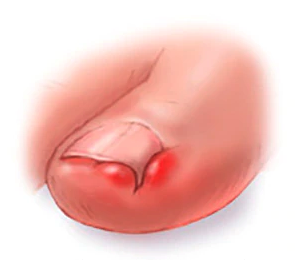
Ingrown Nail
Onychocryptosis (ingrown nail) is a condition that can affect one or both borders of any nail. Typically it involves the big toe. The condition can result from trauma to the nail plate or matrix, genetics, fungal infection, or over-zealous or improper trimming of the toenail. It may lead to severe pain, swelling, or infection. Pain is caused by the nail growing either medially or laterally (depending on which nail border is involved) into the periungual soft tissue, acting like a foreign body. Secondary dermatologic changes may also occur, such as a pyogenic granuloma or chronic granulation tissue (“proud flesh”).
The condition can be treated by wedge resection, nail avulsion of the offending border. A new nail will return after six to 12 months or more. If the condition is chronic by history, or if recurrence takes place, matrixectomy should be considered. A matrixectomy (permanent removal) can be performed either by chemical (phenol) or surgical methods. Patient factors combined with the history and physical help determine the appropriate method for each patient.
